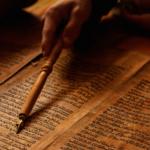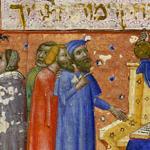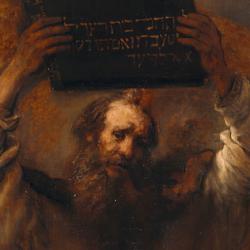The First of the Ten Words speaks to the question of whom we worship: We are to have no other gods before the face of Yahweh. The Second Word had to do with how we worship: We are to approach God as He commands us to approach Him.
The Second Word is sometimes misunderstood. It has gotten tangled up in debates about whether or not we can paint or draw pictures, or make sculptures, of Jesus, or of God the Father. It’s been taken as a prohibition of placing art, especially representational art, in a place of worship. Some claim that is prohibits all representational art.
That last at least takes the specifics of the commandment seriously. If the Second Word is a prohibition of making images, it prohibits all images. The commandment doesn’t say “Don’t make images of God.” It says “Don’t make graven images of things in heaven, on the earth, or the waters under the earth.” That covers everything, because there aren’t any things anywhere except in heaven, earth, or under the earth.
But the commandment doesn’t prohibit making images. If it were, it would stand in contradiction to other commandments. Just a few chapters later, the Lord will tell Moses to “make two cherubim of gold“ (25:18), and a lampstand with cups “shaped like almond blossoms” (25:33), and pomegranates of blue and scarlet material (28:33). Cherubim are heavenly things, almonds and pomegranates are earthly things. Palm trees were carved on the walls of the temple, and Solomon’s throne was flanked by lions. If the Second Word was intended to prohibit all representational art, the Lord didn’t stick with that program very long.
The Lord doesn’t contradict himself. He’s not prohibiting making, or making things that resemble things that He made. He’s prohibiting making likenesses of anything for a particular purpose – to bow before them, and to serve them.
The two verbs in verse 5 are typical words for worship. The word usually translated as “worship” actually means “prostrate oneself.” It describes a bodily posture. “Serve” is a general priestly term, describing the work of Levites and Aaronic priests.
God forbids making images that serve as the focal point of liturgical action. Most directly, He is prohibiting the service that ancient priests performed did before the images of their gods. A temple without an image was a temple without a god-in-residence, and the main services of a temple were performed before and for the image. Priests brought food, cleaned up the image, bowed before the image. On special occasions, the priests took the image out on processions, so that others could glimpse the image, though often under a cover.
What Yahweh specifically prohibits is “prostration” before images. He prohibits us from adopting a particular bodily posture before graven images. That is, He doesn’t say it’s OK if we bow with our bodies as long as we’re not bowing in our hearts. He’s doesn’t say that we’re free to use our bodies any way we like, as long as we keep the right thoughts in our head. He prohibits a particular bodily action.
Of course, bodily actions embody intentions. If a priest dropped a piece of bread before the lampstand and bent down to pick it up, he wouldn’t be violating this commandment. God is specifically prohibiting the bodily act of doing-homage-by-prostration, and more generally prohibiting the actions of doing-homage-to-images and serving-images. God cares what we do with our bodies, and a good intention doesn’t make a bad action good.
Isaiah mocks idolaters for making a god from a log and using the rest of the log to cook food and warm themselves. It looks so obviously stupid that we have to ask: Did ancient people really think that the image was the god?
It’s virtually impossible to tell what ancient people thought about their gods, but from the written sources it seems that the answer, at least for thoughtful elites, was No. Everyone understood that the chunk of wood wasn’t the same as Zeus or Athena, that the bronze image wasn’t Baal or Asherah or Ra.
Instead, they thought that the image was a point of connection with the god. The image of the god was a sign of the presence of the god, and the service done to the image was implicitly service done to the god. Some rituals from ancient world indicate that the rites done before an image were intended to “download” the divine essence into the image. Priests do their work before the statue to “quicken” the divine essence in the statue. The metal wasn’t the god, but it became identified with the god, filled with divine power, a connection point between the worshiper and the god. Being with the image meant being in the presence of the god him or herself. The image was seen as a “sacrament” of the god’s presence.
Yahweh’s prohibition of images is even more radical than we might realize. He isn’t just saying “I’m not made of stone, wood, bronze, gold.” Everyone already knew that the gods weren’t made of such things. He’s saying, “Don’t think you can serve Me by serving an image, that you can honor me by honoring a likeness of Me.” The Second Word, in short, prohibits Israel from what to ancient people was the normal business of worship.
In my judgment, nothing in the new covenant changes this prohibition. Jesus is the Son of God in flesh, visible and tangible, photographable and pictureable. There’s nothing wrong with drawing a picture of Jesus. There’s nothing wrong with stained glass windows, murals, or statues in church. But then there never was anything wrong with pictures, windows, murals, or statues. At Sinai and still today, the issue is how these images are used.
If this is correct, then a large segment of the Christian church is corrupted with liturgical idolatry condemned by the Second Word. No Orthodox believer believes that the icon is identical to the saint depicted in the icon. No one thinks that an icon of Christ is Christ. Yet Orthodox Christians do believe that icons are “sacraments” of the presence of Christ or the saints, and that veneration of the icon is a way of doing homage to the one depicted in the icon. That is precisely what God forbids.
Debates about the Second Word sometimes get tangled with debates about the capacity of matter to convey God’s presence. John of Damascus felt he needed to defend the goodness of creation against what he perceived as the semi-gnosticism of the iconoclasts.
But that’s not the issue. The question isn’t whether physical things, man-made things, can become vehicles for God’s self-communication, places and moments of communion with God. The question is which things and moments has God given as vehicles for His self-gift.
Jesus gave us have physical signs of God’s presence, the bread and the wine of Eucharist, the water of baptism, the visual and audible words of God in Scripture, the renewed image of God in fellow believers. Jesus has promised to give life by the Spirit through these physical means. He hasn’t promised that He will encounter us in pictures and images. When Christians seek an encounter with Jesus through an image, they’re looking for God in the wrong place.











